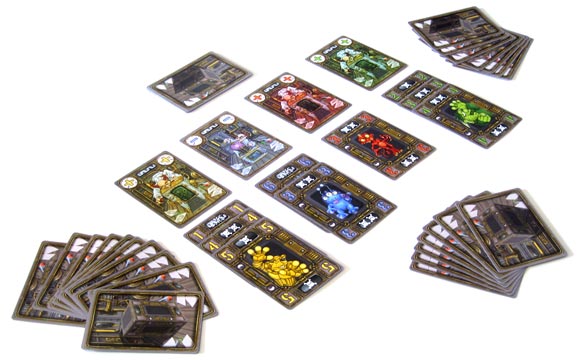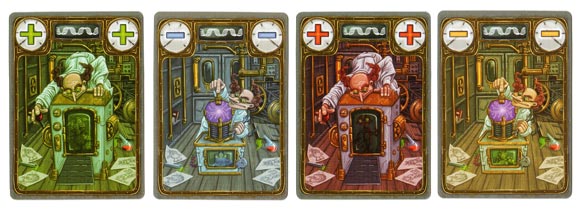
Crazy Creatures of Dr. Gloom

Family Focus Review
These reviews provide insight on some of the best games for families with young gamers. Written from a parent’s perspective for a fun and educational family game night!
Overview
In The Crazy Creatures of Dr. Gloom each player is an aspiring apprentice to Dr. Gloom, seeking to create all the creatures in their hand using four color-coded machines on the table. Creatures must be created in advancing, or reversed sequential order depending on the current setting of the machine that matches that monsters color and type. Play cards to reverse the machines, and force other apprentices to draw cards. A round ends when any player plays their last card. Players score penalty points for creatures left in their hands. Be the player with the last points at the end of the final round an become the new apprentice to Dr. Gloom!
Set Up
The game begins with four monster machines face up on the table. Each machine has a plus (+) sign on one side, and a minus (-) sign on the other. All machines start on the plus side. The creature deck is made up of 48 creatures: 12 of four different colors. (red, green yellow and blue.) The deck is shuffled, and depending on the number of players, the apprentices are dealt a hand of 10 or 12 Creatures. Eight reserve cards are then dealt face down to a stack near the Machine cards. The rest of the Creature cards are placed back in the box and not used in this game. The game will last a number of rounds equal to the number of apprentices playing.

Gameplay
On their turn, each apprentice creates a creature using a Machine matching the color and type of the Creature created. They play the card next to that machine. Each creature has a numerical rating or serial number, that rates their security level. An apprentice may only play a card that is equal to or higher than the previous creature played to that machine if the machine displays the plus (+) side, or less than or equal to the previously played creature if the machine displays the minus (-) side. Some creatures have a genetic mutation symbol on them. These creatures can be played on any previously played creature as long as they match the color and type of the machine.

If an apprentice plays a creature with an equal security level as the previously played creature, that apprentice must either, change the machines setting, flipping the machine card to its opposite output (plus or minus) or force another apprentice to draw a card from the reserve deck. Remember all apprentices are trying to get rid of their cards!
Once any apprentice has played their last card, all other apprentices get one more turn each to create creatures and rid their hands of penalty points (depicted as skull and crossbones on the Creature cards). Once one round ends, a new round begins using the same setup as the first, and play continues until the apprentices have played a number of rounds equal to the number of players. After which, all scores are totaled, and the apprentice with the least number of Penalty Points is declared the next apprentice to Dr. Gloom!
Components
Dennis Lohausen breathes life into the game with some wonderfully unique creatures and graphics – a tall order these days in a toy and game market crowded with wacky creatures of every shape and description. Each Creature is explained and detailed in notebook style sketches in the instruction book, and every creature card is depicted as growing, (evolving?) into a more serious and more threatening version of its cute little “Level 1” self. The rulebook is well written with ample images. The storage tin houses the cards nicely and adds a nice collectible feel to the game.
Learning Curve
Rated for ages 7 and up, I would venture to say that even younger players could learn and play the game with some parental help. Piece if cake!
Educational Value
The Crazy Creatures of Doctor Gloom can help develop:
- Color recognition
- Decision making
- Numerical sequencing
- Memory
- Critical thinking
As with many games it also creates an environment for adults to help children develop patience and good sportsmanship since apprentices do have a chance to foil other players instead of initiating their own strategy.
Final Thoughts
Although simple in its design and perhaps similar to other card games where sequential numerical play and ridding one’s hand of cards is the primary focus and goal, Michael Schacht‘s design of The Crazy Creatures of Doctor Gloom offers a couple of key aspects that create an entertaining and challenging game experience.
The first is the use of Machines that can be set to force players to play cards with a higher numerical value than the previously played card, or lower numerical value depending on the facing of the Machine card. This creates a fluctuating game condition that instantly changes the intrinsic value of the cards in one’s hand. It also enables a player to tweak the game board to favor their own hand, if they are able to pull off the card combination. (Play a card of equal value to a matching machine then follow up with card that matches that sequential order in subsequent turns). The eligibility of being able to change a machine’s function (by playing a card with an equal number to a stack) is limited and more difficult with more than 2 players, but it can prove to be a game changer. As a result, and since all apprentices are aware that if a player changes the function of a machine they may have a strategy in mind, opponents may rush to change it back – effectively creating a competitive interaction that is missing in other card games of this type. In addition, forcing another player to draw a card can be either hurtful, in that they may draw and unplayable card, or helpful, putting a card into hand that unlocks a new sequence and may help them empty their hand. This is a more risky option, and must be timed well.
Another unique aspect is the fact that for 2-3 player games, all the cards are not used in each round. In a two-player game, 16 cards will be left out of the deck (33%!) and in a three-player game, four cards will be left out. (All available creature cards are used in a four-player game). This creates a very volatile and unpredictable two-player experience. In contracts, many games lose the strength of the interactivity and unpredictability when two players are engaged – each reacting to the other’s card play, knowing eventually they will see the card they need and if they don’t, knowing the other player has it. But the two player version of The Crazy Creatures of Doctor Gloom actually creates a volatile game experience where players can’t be sure what cards the other players holds. This opens the door to bluffing and intensifies the guesswork during the game.
Set the technical aspects of a card game design aside and you have a game that is easy to learn, employs a familiar but engaging set of mechanics, and uses some wonderful illustration and characters to provide a quick and at times brainy game that offers players a choice – pursue your own line of card play strategy, or divert and attempt to derail other apprentices.
As a family game, and especially one-on-one with a parent and child it offers an enchanting, and challenging experience. As a fun-filler, it can provide a unique set of gameplay outcomes that will thrill and surprise most avid gamers.
User Reviews (1)
Add a Review for "Crazy Creatures of Dr. Gloom"
You must be logged in to add a review.


I wondered at first how to best review this game, because it’s certainly a type of game that will only appeal to family gamers or children primarily. But that’s not entirely doing the game justice, as it does have a smidgen of strategy to it, just not anywhere near what you would find in a game like “Smash Up”.
My wife put it best while playing – “This is kind of like Uno, but better”.
I hadn’t thought of it that way, and really, the game IS kind of like a new, updated and rethemed version of Uno. Without skip cards. You can make a player draw a card, change the direction of play on a machine (ascending or descending numbers), and it’s basically matching colors and number sequences.
Knowing that, when I First opened the box I had a feeling of dread. I remembered purchasing “Godzilla Stomp!” last year, and finding that horribly bland/overly simplistic. Even my daughter, at age 6 at the time, didn’t like it. At first glance, seeing that there were 4 machines, that players play numbers to in an attempt to get rid of their cards and score at the end, I was reminded of that previous horrible game and wasn’t looking foward to playing.
Basic gameplay goes like this:
There are 4 machines on the board. Yellow, Green, Blue, Red. They all start out with a “+” sign on them, showing that numbers must be played in ASCENDING order, and match the color. That’s basically it. If there are no numbers on a machine, a player can play any number of that machine’s color on it.
From there, 1’s and 6’s are playable on each other, regardless of the direction of numerical order (Ascending/descending). This is the first layer of strategy, saving those cards to be able to reverse the direction of flow on a machine, so you can get rid of some cards otherwise not playable.
On top of that, if you play a duplicate (red 5 on a red 5, for example), you get a choice – flip a machine (changing from + to -, or vice versa) or give a player of your choice an extra card.
This little bit alone adds an interesting (Albeit small) layer of strategy and “Take that” possibility, which greatly enhanced the game.
This helped to not only keep my daughter interested, but my wife and I actually can enjoy playing this game, quite a few rounds of it in fact. I liked Uno as a kid, but not THAT much. Most of my great memories of Uno are because of the time spent playing with my dad, when I was growing up. Nowadays, UNO bothers me because it just doesn’t feel like I’m doing much in the game. UNO still gets play, as my wife and daughter really like it, but this game is highly preferrable. That is a big plus for me, because although I like some random, I like to also feel like I have SOME control over the game outcome or flow.
All in all, don’t let this game slip past you if you are looking for a quick, easy, very inexpensive game to play with your family. I hesitate on giving it a higher score, only because it’s not THAT deep or customizable, but it doesn’t really claim to be. And I don’t think that hurts the game, honestly. It is what it is, and it does it very well.